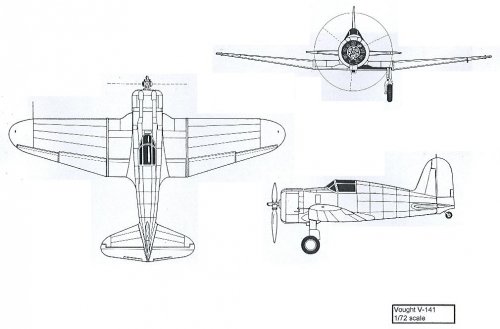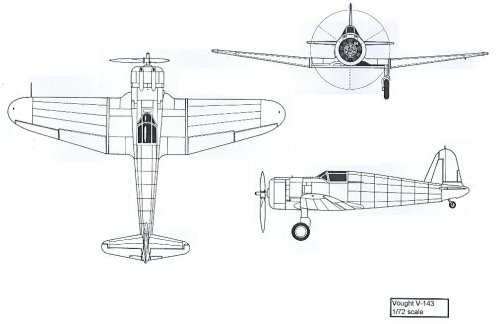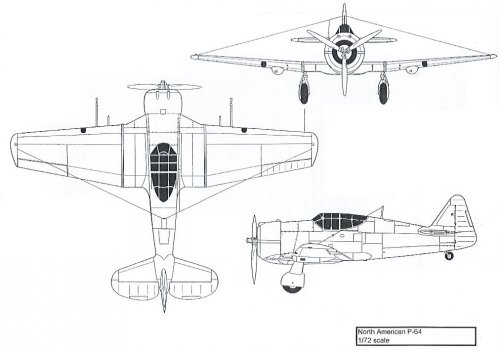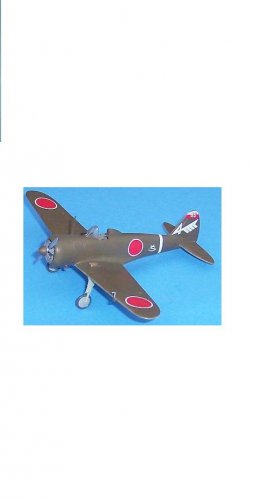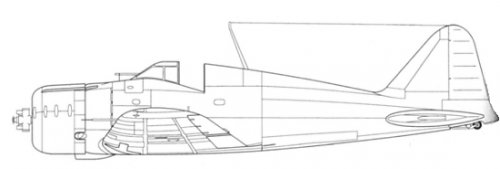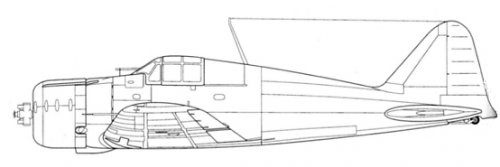You are using an out of date browser. It may not display this or other websites correctly.
You should upgrade or use an alternative browser.
You should upgrade or use an alternative browser.
A6m open cockpit
- Thread starter swallow
- Start date
- Joined
- 22 January 2006
- Messages
- 4,216
- Reaction score
- 2,014
...very interesting, I'll take a look at Putnam's Japanese Aircraft this evening.A6m Zero early design with an open cockpit
airman said:Not exist an A6M with open cockpit like A5M!
Here a target towing variant with open cockpit.
Wy not a prototype?
Attachments
- Joined
- 22 January 2006
- Messages
- 4,216
- Reaction score
- 2,014
Well, I haven't found no A6M info at Putnam's Japanese Aircraft 1910-1941. Mitsubishi last entry at Naval Fighters is Experimental 9-Shi Single-seat fighter (Ka-14). It entered service as Type 96 (A5M). "Claude" in allied code-name.
http://en.wikipedia.org/wiki/Mitsubishi_A5M
(I don't understand why the Zero is not included in the book since its initial design dates back from 1937)
An open cockpit A6M could be possible at a very early stage. IJN requested a fighter capable to fly at speeds about 500 Km/h. The A5M (a design from 1934) max speed was about 430 Km/h and had open cockpit. We will see...
BTW, did you know that a journalist (Drew Pearson) raised an accusation against Vought in 1946. The charge was treason because he maintained the theory that the Zero had been designed upon the Vought V-143 sold to Japan in 1937. Of course it was absolutely no connection between both designs. Japanese armed forces tested the V-143 against its fighters and they found nothing into the american design. However the V-143 was an ancestor of the V-166B (the mighty F4U Corsair).
http://en.wikipedia.org/wiki/Mitsubishi_A5M
(I don't understand why the Zero is not included in the book since its initial design dates back from 1937)
An open cockpit A6M could be possible at a very early stage. IJN requested a fighter capable to fly at speeds about 500 Km/h. The A5M (a design from 1934) max speed was about 430 Km/h and had open cockpit. We will see...
BTW, did you know that a journalist (Drew Pearson) raised an accusation against Vought in 1946. The charge was treason because he maintained the theory that the Zero had been designed upon the Vought V-143 sold to Japan in 1937. Of course it was absolutely no connection between both designs. Japanese armed forces tested the V-143 against its fighters and they found nothing into the american design. However the V-143 was an ancestor of the V-166B (the mighty F4U Corsair).
pometablava said:Well, I haven't found no A6M info at Putnam's Japanese Aircraft 1910-1941. Mitsubishi last entry at Naval Fighters is Experimental 9-Shi Single-seat fighter (Ka-14). It entered service as Type 96 (A5M). "Claude" in allied code-name.
http://en.wikipedia.org/wiki/Mitsubishi_A5M
An open cockpit A6M could be possible at a very early stage. IJN requested a fighter capable to fly at speeds about 500 Km/h. The A5M (a design from 1934) max speed was about 430 Km/h and had open cockpit. We will see...
BTW, did you know that a journalist (Drew Pearson) raised an accusation against Vought in 1946. The charge was treason because he maintained the theory that the Zero had been designed upon the Vought V-143 sold to Japan in 1937. Of course it was absolutely no connection between both designs. Japanese armed forces tested the V-143 against its fighters and they found nothing into the american design. However the V-143 was an ancestor of the V-166B (the mighty F4U Corsair).
This type of resemblance is very frequent.
There are three good artcles on the V.143 published in Le Fanatique de l'Aviation
-"Deux constructeurs Américains pour un seul client:Le Japon" Nr.109 & 110
-"Northrop Model 3A ,Vought V-141/143"
-"Les Maîtres copieurs"
Where it is said that at least the undercarriage retraction system was actually copied from the V-143.
Perhaps the japanese fighter of 500 Km/h was the Mitsubishi A5M3 with Hispano Suiza in line engine?
It may also be possible that it was mistaken for the Manshu Ki 79a?
Attachments
- Joined
- 22 January 2006
- Messages
- 4,216
- Reaction score
- 2,014
Perhaps the japanese fighter of 500 Km/h was the Mitsubishi A5M3 with Hispano Suiza in line engine?
Sorry Justo, I didn't express properly. I tryed to say that the IJN requeriment that originated the Zero requested a speed of 500 Km/h.
- Joined
- 22 January 2006
- Messages
- 4,216
- Reaction score
- 2,014
Courtesy of Lark, here it is the open cockpit A6M early design plus another early concept with closed cockpit.
Source:
Biblioteka Magazynu Lotnictwo Mitshubishi A6M2 Reisen Zero/Zeke page 16.
A real great finding, thanks Lark
Source:
Biblioteka Magazynu Lotnictwo Mitshubishi A6M2 Reisen Zero/Zeke page 16.
A real great finding, thanks Lark
Attachments
- Joined
- 27 December 2005
- Messages
- 17,748
- Reaction score
- 26,421
topic unlocked.
That second drawing has somewhat of a Grumman Hellcat look to it - interesting.
Regards,
Greg
Regards,
Greg
J
joncarrfarrelly
Guest
Well the profiles are interesting and all, but, what is the evidence for those layouts?
Simply posting illustrations from an obscure reference is not proof of anything, what
evidence did they use in drafting those layouts?
Are there any Japanese sources that affirm these profiles?
The early versions of the A5M2b had an enclosed cockpit in 1937, later versions went back to an open cockpit because the pilots whined, but I don't see Horikoshi and Co. backpedaling and agreeing to an open cockpit on his new design.
I'm willing to be convinced otherwise, but not by a couple of unsupported profiles.
Jon
Simply posting illustrations from an obscure reference is not proof of anything, what
evidence did they use in drafting those layouts?
Are there any Japanese sources that affirm these profiles?
The early versions of the A5M2b had an enclosed cockpit in 1937, later versions went back to an open cockpit because the pilots whined, but I don't see Horikoshi and Co. backpedaling and agreeing to an open cockpit on his new design.
I'm willing to be convinced otherwise, but not by a couple of unsupported profiles.
Jon
The drawings were based on wooden windtunnel models made
in the initial design phase of the Zero.
To state that the the Polish books series is an obscure source is a bit 'to far' I think.
Besides , several fighter concepts who saw action in WW II started life as an open cockpit design.
The Heinkel He-112 for exemple...
in the initial design phase of the Zero.
To state that the the Polish books series is an obscure source is a bit 'to far' I think.
Besides , several fighter concepts who saw action in WW II started life as an open cockpit design.
The Heinkel He-112 for exemple...
- Joined
- 22 January 2006
- Messages
- 4,216
- Reaction score
- 2,014
Simply posting illustrations from an obscure reference is not proof of anything
Jon,
Your post is very welcome. Since we work here to have a first class authoritative forum, critical awareness is really needed.
My personal opinion is the following:
I agree with Lark.
Jon, your reasoning could invalidate the 90% of the posts in that forum. Remember that only a minority of members posting here, validate their contributions with bibliography.
I can be sure that I don't know what you think "Biblioteka Magazynu Lotnictwo Mitshubishi A6M2 Reisen Zero/Zeke page 16" is an obscure source from the start. Well, possibly it is not popular. But this is not a reason to invalidate it. AW&ST published inconsistent news sometimes in the past. I think "found on internet" or "read it elsewhere" are obscure sources from the start. Why do you think Biblioteka Magazynu Lotnictwo is not credible?.
Best regards,
Antonio
BTW, any Polish member could contribute with his opinion about that mag?
The author of that monography about Mitsubishi Zero specializes in Japanese aviation of the Second World War. He was (is???) the editor of the "Lotnictwo Wojskowe/Lotnictwo" Magazine (it used to be a mag about military aviation but naw it's a mag about aviation in general, although it has historical part). The monography is quite "fresh", and the author had been working on it for over a year, I think. Now he is preparing second part. If someone calls the source of the photos obscure he is...sorry Winnetou you're wrong. Those drawings base on the photos, as Lark has mentioned, of the windtunnel models.
Jon, look what happend to Italian monoplane fighters. They were designed with closed cockpit but pilots preferred open one. The same situation could have taken place during works on Zero. And if Hirikoshi had had to redesigned Claude, he maight have prepared open cockpit version of A6M.
Regards
Dominik
joncarrfarrelly said:The early versions of the A5M2b had an enclosed cockpit in 1937, later versions went back to an open cockpit because the pilots whined, but I don't see Horikoshi and Co. backpedaling and agreeing to an open cockpit on his new design.
Jon
Jon, look what happend to Italian monoplane fighters. They were designed with closed cockpit but pilots preferred open one. The same situation could have taken place during works on Zero. And if Hirikoshi had had to redesigned Claude, he maight have prepared open cockpit version of A6M.
Regards
Dominik
J
joncarrfarrelly
Guest
Dominik said:The author of that monography about Mitsubishi Zero specializes in Japanese aviation of the Second World War. He was (is???) the editor of the "Lotnictwo Wojskowe/Lotnictwo" Magazine (it used to be a mag about military aviation but naw it's a mag about aviation in general, although it has historical part). The monography is quite "fresh", and the author had been working on it for over a year, I think. Now he is preparing second part. If someone calls the source of the photos obscure he is...sorry Winnetou you're wrong. Those drawings base on the photos, as Lark has mentioned, of the windtunnel models.
joncarrfarrelly said:The early versions of the A5M2b had an enclosed cockpit in 1937, later versions went back to an open cockpit because the pilots whined, but I don't see Horikoshi and Co. backpedaling and agreeing to an open cockpit on his new design.
Jon
Jon, look what happend to Italian monoplane fighters. They were designed with closed cockpit but pilots preferred open one. The same situation could have taken place during works on Zero. And if Hirikoshi had had to redesigned Claude, he maight have prepared open cockpit version of A6M.
Regards
Dominik
Gee folks, I'm well aware of the Italian fighters, the He 112 and the conservatism of fighter pilots.
Don't assume I'm ignorant of basic aircraft history.
Thanks all the same.
The profiles are still an interpretation not an original source, better to post the photos of the wind tunnel models.
As to obscurity, many of the sources on this site are obscure, which is an observation not a criticism.
- Joined
- 22 January 2006
- Messages
- 4,216
- Reaction score
- 2,014
I'll post the photos tomorrow
I'm sorry for the delay, as a compensation here is the full page
Attachments
Hi everyone
To say something , as far as I know was the " Zero " ( 12-Shi )
a new design , and not a modification of the " Claude "!
The Zero was a replacement for the A5M ( 9-Shi ).
Source : Japanese Aircraft of the Pacific War R.J.Francillon.
To say something , as far as I know was the " Zero " ( 12-Shi )
a new design , and not a modification of the " Claude "!
The Zero was a replacement for the A5M ( 9-Shi ).
Source : Japanese Aircraft of the Pacific War R.J.Francillon.
J
joncarrfarrelly
Guest
Very late response here.pometablava said:I'll post the photos tomorrow
I'm sorry for the delay, as a compensation here is the full page
I stand by my earlier position about those 'profiles' ,indeed the photos of the wind tunnel models strengthen my opinion.
The models are of a radial powered design with an enclosed or open cockpit, to then create line drawings that add an A6M type tail and wing and then say "lookie here the Zero originally had an open cockpit " is a real stretch. Especially as the lines on the profiles don't jibe in several points with the shapes and proportions visible in the photos.
I have no problem with the wind tunnel models being used in the development process for the 12 shi fighter, but that doesn't make them
necessarily an early A6M.
Jon
lucamax
ACCESS: Secret
In the post you mentioned an A5M with the in line engine: can you tell me more? Studying the history of the aircraft I found a reference to a competitor proposed by Nakajima: do you know something about it?
- Joined
- 25 July 2007
- Messages
- 4,299
- Reaction score
- 4,196
pometablava said:...
BTW, any Polish member could contribute with his opinion about that mag?
Indeed. A glance at Polish discussion groups suggests that the author, Krzysztof Zalewski, is well regarded. BTW, the book is available for 36,00zł which works out to about £8.02, €9.25, of US$13.02.
Similar threads
-
-
16 shi specifications for Zero replacement
- Started by Hardrada55
- Replies: 1
-
-
-


